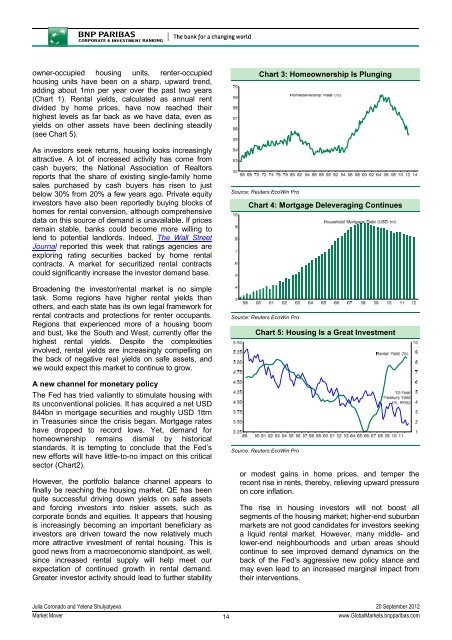MARKET MOVER - BNP PARIBAS - Investment Services India
MARKET MOVER - BNP PARIBAS - Investment Services India
MARKET MOVER - BNP PARIBAS - Investment Services India
You also want an ePaper? Increase the reach of your titles
YUMPU automatically turns print PDFs into web optimized ePapers that Google loves.
owner-occupied housing units, renter-occupied<br />
housing units have been on a sharp, upward trend,<br />
adding about 1mn per year over the past two years<br />
(Chart 1). Rental yields, calculated as annual rent<br />
divided by home prices, have now reached their<br />
highest levels as far back as we have data, even as<br />
yields on other assets have been declining steadily<br />
(see Chart 5).<br />
As investors seek returns, housing looks increasingly<br />
attractive. A lot of increased activity has come from<br />
cash buyers; the National Association of Realtors<br />
reports that the share of existing single-family home<br />
sales purchased by cash buyers has risen to just<br />
below 30% from 20% a few years ago. Private equity<br />
investors have also been reportedly buying blocks of<br />
homes for rental conversion, although comprehensive<br />
data on this source of demand is unavailable. If prices<br />
remain stable, banks could become more willing to<br />
lend to potential landlords. Indeed, The Wall Street<br />
Journal reported this week that ratings agencies are<br />
exploring rating securities backed by home rental<br />
contracts. A market for securitized rental contracts<br />
could significantly increase the investor demand base.<br />
Broadening the investor/rental market is no simple<br />
task. Some regions have higher rental yields than<br />
others, and each state has its own legal framework for<br />
rental contracts and protections for renter occupants.<br />
Regions that experienced more of a housing boom<br />
and bust, like the South and West, currently offer the<br />
highest rental yields. Despite the complexities<br />
involved, rental yields are increasingly compelling on<br />
the back of negative real yields on safe assets, and<br />
we would expect this market to continue to grow.<br />
A new channel for monetary policy<br />
The Fed has tried valiantly to stimulate housing with<br />
its unconventional policies. It has acquired a net USD<br />
844bn in mortgage securities and roughly USD 1ttrn<br />
in Treasuries since the crisis began. Mortgage rates<br />
have dropped to record lows. Yet, demand for<br />
homeownership remains dismal by historical<br />
standards. It is tempting to conclude that the Fed’s<br />
new efforts will have little-to-no impact on this critical<br />
sector (Chart2).<br />
However, the portfolio balance channel appears to<br />
finally be reaching the housing market. QE has been<br />
quite successful driving down yields on safe assets<br />
and forcing investors into riskier assets, such as<br />
corporate bonds and equities. It appears that housing<br />
is increasingly becoming an important beneficiary as<br />
investors are driven toward the now relatively much<br />
more attractive investment of rental housing. This is<br />
good news from a macroeconomic standpoint, as well,<br />
since increased rental supply will help meet our<br />
expectation of continued growth in rental demand.<br />
Greater investor activity should lead to further stability<br />
Chart 3: Homeownership Is Plunging<br />
Source: Reuters EcoWin Pro<br />
Chart 4: Mortgage Deleveraging Continues<br />
Source: Reuters EcoWin Pro<br />
Chart 5: Housing Is a Great <strong>Investment</strong><br />
Source: Reuters EcoWin Pro<br />
or modest gains in home prices, and temper the<br />
recent rise in rents, thereby, relieving upward pressure<br />
on core inflation.<br />
The rise in housing investors will not boost all<br />
segments of the housing market; higher-end suburban<br />
markets are not good candidates for investors seeking<br />
a liquid rental market. However, many middle- and<br />
lower-end neighbourhoods and urban areas should<br />
continue to see improved demand dynamics on the<br />
back of the Fed’s aggressive new policy stance and<br />
may even lead to an increased marginal impact from<br />
their interventions.<br />
Julia Coronado and Yelena Shulyatyeva 20 September 2012<br />
Market Mover<br />
14<br />
www.GlobalMarkets.bnpparibas.com
















